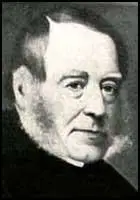Nicholas Wood

Nicholas Wood was born in 1795. He became the colliery manager at Killingworth Colliery where he met George Stephenson. In 1814 the two men worked together on the building of the Blutcher. Wood gradually became more knowledgeable about locomotives and in 1820 he proposed the use of steam as a compressible medium for locomotive springing.
In 1825 Wood's influential book, A Practical Treatise on Railroads was published. In the book, Wood argued strongly that it was better to use steam locomotives than stationary engines on railways. Nicholas Wood gave parliamentary evidence in favour of the Liverpool & Manchester Railway and in 1829 was one of the three judges at the Rainhill Trials.
In 1844 Wood became a partner in the company that owned Hetton Colliery. He played an active role in improving mining safety and was an instigator of the 1851 Mines Inspections Act. Nicholas Wood died in 1865.
Primary Sources
(1) Nicholas Wood, Treatise on Railroads (1825)
It is far from my wish to promulgate to the world that the ridiculous expectations of the enthusiastic specialists, that we shall see locomotives travelling at the rate of 12, 16, 18 or 20 miles an hour; nothing could do more harm towards their adoption, or general improvement, than the promulgation of sich nonsense.
(2) John Sykes was one of those who witnessed the opening of the Stockton to Darlington Railroad.
The novelty of the scene, and the fineness of the day, had attracted an immense concourse of spectators, the fields on each side of the railway being literally covered with ladies and gentlemen on horseback, and pedestrians of all kinds. The train of carriages was then attached to a locomotive engine, built by George Stephenson, in the following order: (1) Locomotive engine, with the engineer (Mr. George Stephenson) and assistants. (2) Tender, with coals and water; next, six wagons, laden with coals and flour; then an elegant covered coach, with the committee and other proprietors of the railway; then 21 wagons, fitted up for passengers; and last of all, six wagons laden with coal, making altogether, a train of 38 carriages. By the time the cavalcade arrived at Stockton, where it was received with great joy, there were not less than 600 persons within, and hanging by the carriages.
(3) George Stephenson, letter published in The Philosophical Magazine (13th March, 1817)
I observe you have thought proper to insert the last number of the Philosophical Magazine your opinion that my attempts at the safety tubes and apertures were borrowed from what I have heard of Sir Humprey Davy's researches. The principles upon which a safety lamp might be constructed I stated to several persons long before Sir Humphrey Davy came into this part of the country. The plan of such a lamp was seen by several and the lamp itself was in the hands of the manufacturers during the time he was here.
(4) George Stephenson, letter to the directors of the Stockton & Darlington Railway in 1821 after he has seen the rails being made by John Birkinshaw.
To tell you the truth although it would put £500 in my pockets to specify my own patent rails, I cannot do so after the experience I have had.
(5) George Stephenson, letter to Joseph Sandars (December, 1824)
The rage for railroads is so great that many will be laid in parts where they will not pay.
(6) On 25th April, 1825, George Stephenson gave evidence to the House of Commons committee looking into the proposed Liverpool & Manchester Railway. Edward Alderson, the counsel employed by those opposing the railway, severely criticised the evidence given by Stephenson.
This railway is the most absurd scheme that ever entered into the head of a man to conceive. Mr. Stephenson never had a plan - I do not believe he is capable of making one. He is either ignorant or something else which I will not mention. His is a mind perpetually fluctuating between opposite difficulties; he neither knows whether he is to make bridges over roads or rivers, or of one size or another; or to make embankments, or cuttings, or inclined planes, or in what way the thing is to be carried into effect. When you put a question to him upon a difficult point, he resorts to two or three hypothesis, and never comes to a decided conclusion. Is Mr. Stephenson to be the person upon whose faith this Committee is to pass this Bill involving property to the extent of £400,000/£500,000 when he is so ignorant of his profession as to propose to build a bridge not sufficient to carry off the flood water of the river or to permit any of the vessels to pass which of necessity must pass under it.
(7) Robert Stephenson told Samuel Smiles how his father liked to wrestle with his old friend, George Bidder.
When my father came about the office he sometimes did not well know what to do with himself. So he used to invite Bidder to have a wrestle with him, for old acquaintance sake. And the two wrestled together so often, and had so many falls (sometimes I thought they would bring the house down between them), that they broke half the chairs in my outer office.
(8) Edward Pease, diary entry (16th August, 1846)
Left home in company with John Dixon to attend the internment of George Stephenson at Chesterfield. I fear he died an unbeliever. When I reflect on my first acquaintance with him and the resulting consequences my mind seems lost in doubt as to the beneficial results - that humanity has been benefited in the diminished use of horses and by the lessened cruelty to them, that much ease, safety, speed, and lessened expense in travelling is obtained, but as to the results and effects of all that railways had led my dear family into, being in any sense beneficial is uncertain.
